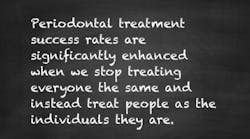Periodontal therapy: How to choose the appropriate adjunctive antimicrobial agent for individual periodontal disease cases
Which periodontal disease cases will benefit from adjunctive systemic antibiotics, and which antibiotic is most appropriate for each individual case? Dr. Richard H. Nagelberg explains how to choose the right antimicrobial for periodontal therapy and how to handle cases that do not respond to treatment.
The standard of care for periodontal therapy is mechanical disruption of the biofilm and chemotherapeutic adjunctive antimicrobials. Other adjunctive agents include host modulatory antibiotics, antioxidants, and probiotics, among others. Some dental practices use the same systemic antibiotics—such as amoxicillin and metronidazole or Augmentin—adjunctively for every case of periodontal disease.Using the same antibiotics for every case brings to mind the idea that even a broken clock is right twice a day. It’s an educated guess at best. With this approach, sometimes there will be disease resolution and sometimes there won’t. But if the adjunctive antibiotic is being chosen randomly, or by habit, how do we know if the antibiotic was the reason for the cases that did not respond to treatment? We don’t.
Which cases will benefit from adjunctive systemic antibiotics? Which antibiotic is most appropriate for each individual case? One irrefutable fact is that there is no silver bullet. Currently, there is no single antibiotic that works for every periodontal pathogen and every case of periodontitis.
According to the bible of periodontics, Carranza’s Clinical Periodontology, the only way to accurately choose the right antibiotic is to identify the bugs you are fighting. Any method of bacterial identification, including culture and sensitivity testing or salivary testing, will indicate the specific bacteria that are responsible for a particular case of periodontal disease and reveal which antibiotics are appropriate. With this approach, there is no guesswork, no crossing fingers and hoping for a favorable outcome.
Beyond that, however, is the elimination of a variable in cases that do not resolve. The key to achieving favorable outcomes in cases such as these is likely something other than the antibiotic recommended by bacterial identification. Perhaps a reexamination of the patient’s risk elements will reveal the reason for nonresponding cases. Additional rounds of therapy may be required. In any case, why wouldn’t we want to stop guessing and get our treatment right the first time? Periodontal treatment success rates are significantly enhanced when we stop treating everyone the same and instead treat people as the individuals they are.
READ MORE OF DR. NAGELBERG’S BLOGS . . .







